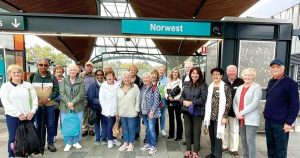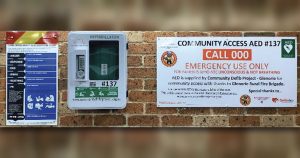During his survey of the district in 1817, James Meehan made the comment that the forests of Dural were so thick that one could hear the men working long before they were seen and the trees would never be cleared. Unfortunately, for the areas on the good soil along the ridges and in the alluvial valleys, time has shown his comments to be wrong. Fortunately, in isolated pockets the once great indigenous trees of the Wianamatta and Hawkesbury soils can still be seen.
It is a fraught debate between loss and gain. From a positive aspect clearing of the forests did give Sydney and our community much of its history and that which we now value. From our forests came the huge Iron Bark beams essential in buildings such as the Hyde Park Barracks and the wool stores, while the Turpentine trees gave the wharf piers of the Harbour. The Casuarina shingles roofed the cottages. The orchards and their later removal gave us income and later the rural character we enjoy.
Some of those trees became part of our own local history. Who can forget the huge Angophora at Bus Stables Corner at the junction of Middle Dural and Galston Roads? It was the community notice board for every event, sale or election. The number of nails in its trunk made it difficult to find a spot for the next person to install their effort. The tall stump on Old Northern Road that still showed the way in which the timber cutter had climbed to a better height to cut down the log he wanted. Less well known was the Apple Gum just past the last bend of the Gorge on the Hornsby side. A lower branch had been cut off to provide a handy throw-over for the reins of the carts. While the drivers gave the horses a spell they had time for a smoke and a chat before the last long climb up the often slippery Red Hill. “Meet you at the Apple Gum “ was a common call for the slow moving trip into Hornsby.
And so it is with sadness that we report on the loss of one of the great survivors. In the last heavy storms the top was taken out of an enormous Turpentine in Arcadia. It must be at least four or five hundred years old. A large section of bark had been removed to provide shelter or transport by much earlier residents. Over the centuries it had developed into the habitat for every conceivable animal, no matter what size. There was no part of even the smallest of hollow branch that was not lived in. It was a the animal Australia Square of Arcadia. It must have survived the harvesting of wharf piers because its trunk, at quite a height, was already too far gone and open enough to allow a child to walk through.
The remnants of those forests still play an important role. As living trees they are the seed source for regeneration and our own good health. The dead ones have an even greater function and they are the most at risk. In our attempt to make things safe and tidy or to provide fire wood they are cut down. Their removal means that, like the tree in Arcadia, the habitat of countless animals is further reduced.
It takes a long time for old trees to reach that special stage in their life. They become part of the history of a family, a community and even a nation. As their beneficiaries we should protect and respect them. They are our local history too. Do readers have one they remember?
Regretfully the June Roughly Memorial Lecture, scheduled for August, has been deferred till August 2021
Dural and District Historical Society http://duralhistoricalsociety.org.au/









